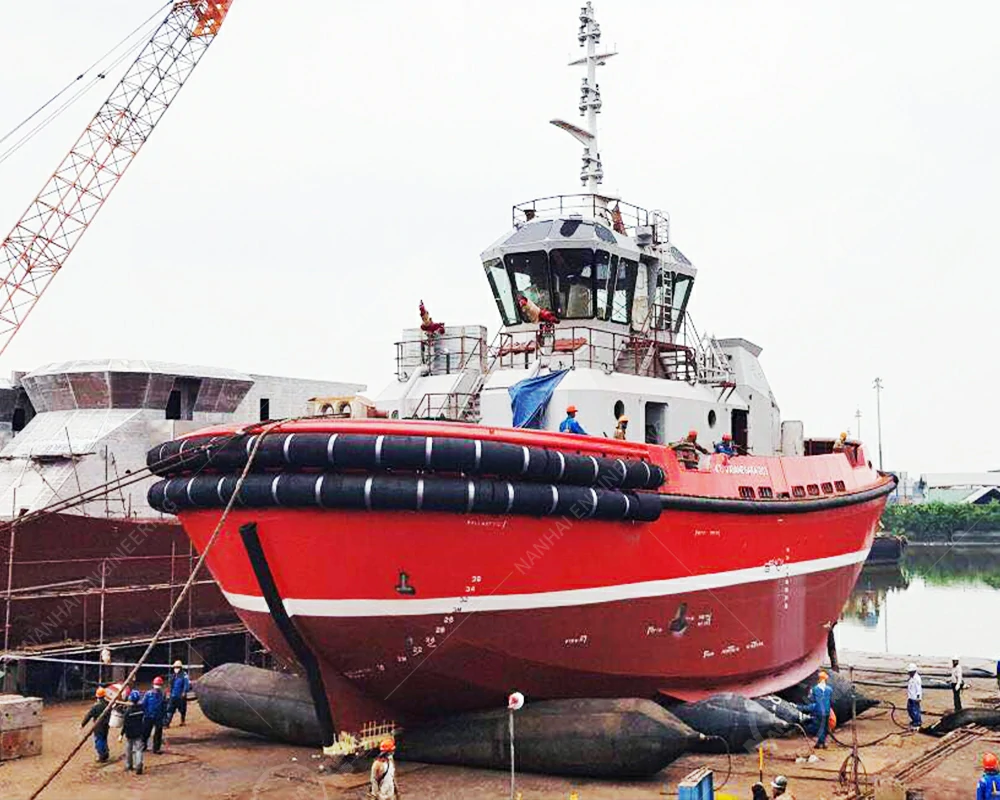Application Fields of Marine Airbags
06/12/2025How to Place Ship Launching Airbags When in Use?
06/12/2025How to ensure safe use of ship airbags
Ship airbags are widely used in ship launching, docking, and relocation. They play a critical role in safely handling heavy vessels. But with that importance comes responsibility—many accidents in shipyards happen not due to technical failure, but because of improper use or poor-quality airbags.

Why Safety Matters More Than Ever
A few years ago, a shipyard decided to save costs by purchasing cheap airbags from an unknown supplier. During the ship launching process, one of the airbags suddenly burst. The vessel dropped onto the ground, causing damage to the hull, delaying the project, and costing the company hundreds of thousands of dollars.
An airbag is like the hands holding your ship—if those hands fail, the consequences can be devastating. That’s why ensuring the safe use of marine airbags is more than just good practice—it’s essential.
Three Critical Elements for Ship Launching Airbag Safety
1. Use High-Quality ship Airbags with Adequate Load Capacity
The first and most important rule is to never compromise on airbag quality.
In the early days, airbags were only used for launching small inland ships. They had simple structures and limited capacity, but failures were rare. Since the 1990s, improved airbag designs made it possible to launch medium-sized ships. However, some manufacturers continued producing outdated, low-capacity models and sold them at low prices, leading to multiple accidents.
Some vessels crashed during launching, with airbags bursting mid-process. In several cases, injuries occurred. The lesson is clear: you must choose airbags that match the weight and structural needs of your vessel.
Inconsistent quality across the market is a real issue. Some marine rubber fenders manufacturers still cut corners. Only trust certified suppliers with a track record in safety and performance.
2. Ensure the Slipway and Launch Ramp Meet Engineering Standards
The condition of your ship platform and launching slope directly affects safety.
In the past, ships were often launched from simple sandbanks. Now, reinforced concrete ramps are the norm. But problems still arise when small slipways are used to launch large vessels without proper evaluation.
There was a case where a ship was being launched on a poorly built ramp. The concrete cracked under pressure, sharp fragments pierced the airbags, and debris hit nearby workers. It was a preventable tragedy.
Always assess slope geometry and load-bearing strength, especially when upscaling operations.
3. Follow Standard Procedures and Train Your Staff
No matter how good your airbags or ramps are, poor handling can still cause accidents.
Roughly half of all airbag-related incidents are due to improper operation. Operators may not understand airbag capacity, forget to inspect the launch area, or panic during abnormal conditions.
Some common mistakes:
- Using the wrong number or size of airbags
- Ignoring uneven forces during ship movement
- Failing to respond calmly when a problem arises
China’s current industry standards require proper training and procedural documentation. Following those standards significantly reduces risk.
Choosing the Right Supplier Makes All the Difference
If you’ve experienced issues with airbags or are just starting, one of the best decisions you can make is to work with a reputable supplier. It’s not just about buying airbags—it’s about purchasing reliability, safety, and expert support.
Look for marine rubber airbag manufacturers that:
- Offer certified and tested products
- Provide technical support and on-site services
- Have experience with various ship types and launching conditions
Companies like NANHAI specialize in customized launching solutions using top-grade ship launching airbags, tailored to your project needs.
People Also Ask
1. How do I know when a marine airbag needs to be replaced?
If you see cracks, swelling, frequent air leakage, or the airbag has been used for over 5 years, it’s time for replacement.
2. What makes a slipway safe for ship launching?
A good slipway should have a smooth gradient, high bearing capacity, no sharp edges, and a suitable length for the vessel’s movement.
3. Can damaged airbags be repaired?
Minor surface damage can be temporarily fixed, but it’s not recommended that they be reused for critical operations.
4. What are the best marine airbag manufacturers to consider?
Choose companies with certified products, engineering support, and international project experience, such as NANHAI.
Bottom line: Safety in marine airbag operations doesn’t come from one step—it comes from doing every step right. From product selection to ramp design and training, each part matters. If you’re planning a ship launch or looking to upgrade your systems, work with the pros, and stay safe.
